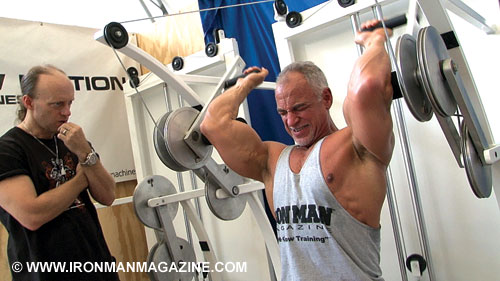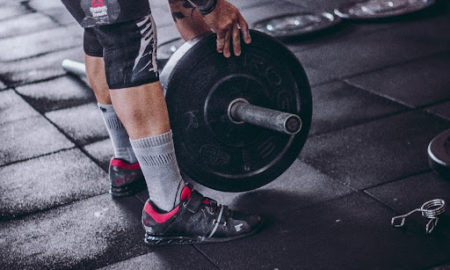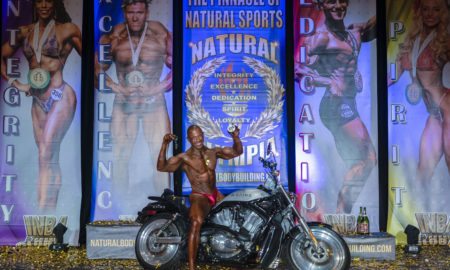
Over the past couple of issues you’ve been introduced to an innovation in weight-training technology: New Motion Machines. This new breed of equipment can add to your training and take you to new heights of performance and development—especially if you’re already training with the Positions of Flexion principles.
We analyzed biceps last month, so let’s continue with the big-arms theme and tackle triceps.
The triceps is the big chunk of meat that fills out the back of the arm. It’s the unsung hero of massive-arm development, actually accounting for about two-thirds of the muscle mass of a well-developed and balanced arm.
When relaxed, the triceps is a long swoop of power that can fill a shirtsleeve and give new confidence. When contracted, it pulls into an eye-catching meaty horseshoe curve. On women the triceps can give a full, healthy and sexy curve to the back of the arm. A pair of developed triceps are the healthy antithesis of bingo wings and stick arms.
The triceps are the action muscles of the arms. They primarily push and throw and are one of the main muscles for bench pressing, punching and jabbing, doing pushups or pushing a heavy shopping cart. They’re also key in all throwing motions: baseball, football, Frisbee, track and field, most swimming strokes, dodgeball—you get the idea. You use your triceps for all sports and every day in life activities. Plus, a good set of triceps just looks cool.
Triceps Anatomy
The triceps not only straightens out your arm but also strongly assists in bringing your upper arm down and backward. It crosses from above and behind the shoulder, down the back of the arm, to below the elbow. The long head of the triceps actually starts on the shoulder blade and then splits to wrap around the back of the arm a bit, attaching just below the elbow.
The lateral and medial heads attach to the upper arm under the shoulder muscles and to the inside of the shoulder. At the other end they attach at the same place as the long head, just below the elbow.
With the help of the rear head of the deltoid, the teres major and minor and even the latissimus, the triceps pulls the upper arm down and back. At the elbow it straightens the arm.
As with the biceps—and all muscles—the triceps is anchored to the bone by Sharpey’s fibers, which are like tree roots. The roots get stronger when you work them and put them under tension. They need to be trained in different positions and under motion to develop the strongest attachments possible. That keeps you from blowing the muscle off the bone when you have extreme pressure or movement. So training the triceps completely means fewer sports injuries, more intense training and better performance over your lifetime.
Remember, the action of the triceps is not only to extend or straighten the elbow but to help pull the upper arm down and back. Its full action is to bring the arm from a position overhead with the elbow flexed and the hand behind or beside your head all the way through to an extended position with the arm down beside the body and straight at the elbow.
Working the Triceps With POF
Since the triceps actually crosses two joints, it has been necessary with conventional equipment to attack it from a variety of angles. To train the triceps totally, you need to use movements that include full extension and full contraction to work the shoulder and elbow attachments in their full range of motion.
Steve Holman, IRON MAN’s editor in chief, has been talking about this brilliant concept for more than 20 years. He coined the term “Positions of Flexion” to convey the importance of training a muscle through its full range of motion with full resistance.
A typical POF triceps workout would consist of lying extensions for the midrange position, overhead extensions for the stretch position and kickbacks for the contracted position. You can substitute exercises for the designated one in each position. For example, you could use close-grip bench presses instead of lying extensions or pushdowns instead of kickbacks.
A solid POF triceps routine consists of six to nine sets—a few sets at each position with the shoulder attachment in static contraction. Unfortunately, your shoulder has to be fairly stationary in each of those positions—but it’s not your fault; it’s a fault of the equipment.
Gravity is the limiting factor. Resistance follows the straight line of gravity. Cables can redirect gravity in a straight line following the cable to the pulley; however, that still creates only partial movements, not true full-range, functional movements.
Traditional triceps machines have managed to place the resistance in an arc around a single pivot point, the elbow, but the shoulder is still static—there is only movement at the elbow, so you’re still doing a partial contraction.
The Future of Resistance Training
As I mentioned last month, Arthur Jones, who developed the Nautilus system, was wrong when he stated in this very magazine: “Obviously I cannot predict the discoveries of the future, and I certainly don’t pretend to be able to, but in this instance, just as obviously, I don’t have to predict the future. All—and I mean ALL—of the important problems connected in the field of weight training have now been solved.”
One of Arthur Jones’ gifts was his genius for publicity. I don’t know whether he was trying to stir up controversy or he actually believed that all major problems in weight training had been solved, but he was wrong.
The dilemma of how to train the muscle groups that cross two joints had been addressed with multiple exercises and Holman’s Positions-of-Flexion concepts, but the problem had not been solved.
Titanic Triceps With New Motion Machines and POF
Now the problem is solved. Imagine going from an overhead press to a lying triceps extension to a cable pushdown to a triceps kickback all in one fluid move with resistance. That’s exactly what the patented device on New Motion Machines enables you to do. It’s exactly what Holman’s POF principle has been talking about. Now there is a tool to make POF a true, functional reality in one fluid move. NMM trains the muscle from all angles with consistent and predictable resistance through its full range of motion.
Now imagine this: You’ve done a few warmup sets of regular lying triceps extensions. You’ve done a set on the NMM triceps before, so you know it moves and feels different from any other piece of equipment you’ve ever been on. You sit down and stretch your arms up and back so your triceps are starting at a full stretch. You engage the machine and feel the resistance on your triceps as soon as you move the weight off the stack. As you contract your triceps, you feel both your elbow and shoulder joints moving. You push through the midrange with power and into full contraction with a strong kickback action that makes you feel as if you’re ready to cramp. You fight the weight back through to a full overhead stretch of the triceps again. On your sixth rep your triceps are really starting to talk to you—then they catch fire.
Blood is pumping like mad, building more capillary beds. More Sharpey’s fibers are being tested at different angles and giving you stronger attachments. You’re activating more muscle per rep through a true full range of motion.
That’s what I and a few select others have been feeling for the past few months. Once you have access to New Motion Machines, your shirtsleeves will start getting tighter, and you’ll notice people glancing at your arms. You’ll also notice new strength and power in all of your pressing moves.
The game has changed with New Motion Machines. Get used to it and grow!
Note: Don’t forget that Positions-of-Flexion training with conventional equipment is a fantastic protocol for building size, strength, speed, endurance and even accelerating weight loss. New Motion Machines are just better, more efficient tools can help you accomplish your goals faster.
Editor’s note: Kurt Edeker D.C., is a father of three, husband, inventor and chiropractor in Austin, Texas. For more information go to www.NewMotionMachines.com. For more on Positions-of-Flexion training, visit www.3DMuscleBuilding.com. IM
















You must be logged in to post a comment Login